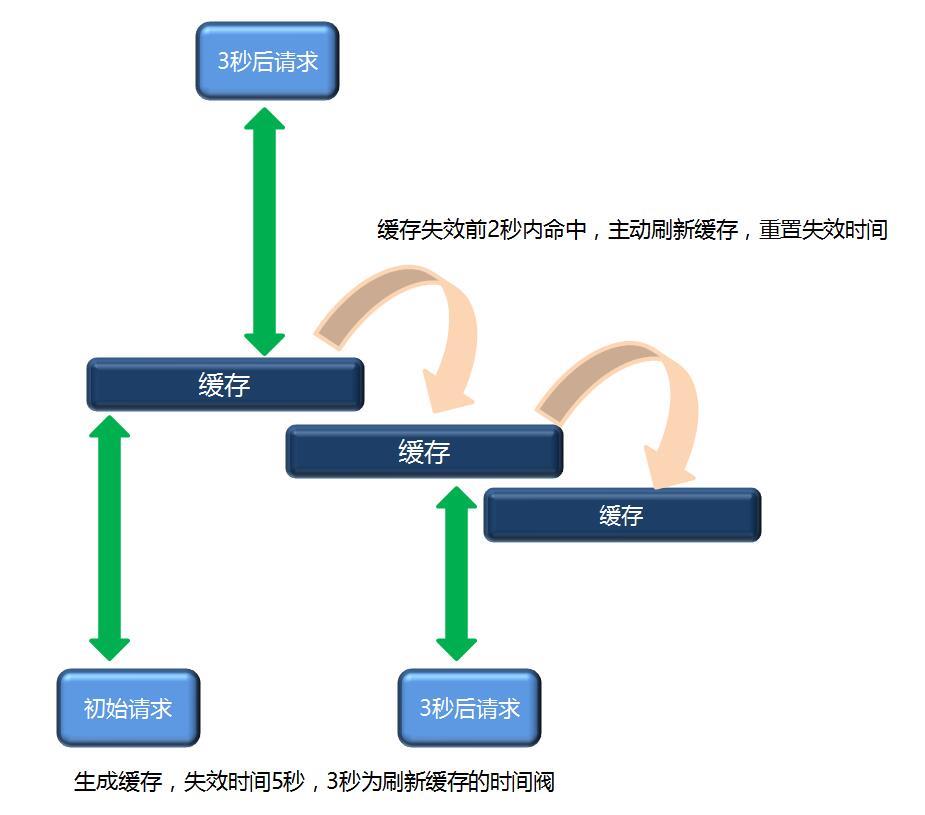深入浅出Spring原理及实战「开发实战系列」Spring-Cache扩展自定义(注解失效时间+主动刷新缓存)
Posted 洛神灬殇
tags:
篇首语:本文由小常识网(cha138.com)小编为大家整理,主要介绍了深入浅出Spring原理及实战「开发实战系列」Spring-Cache扩展自定义(注解失效时间+主动刷新缓存)相关的知识,希望对你有一定的参考价值。
缓存失效时间支持在方法的注解上指定
Spring Cache默认是不支持在@Cacheable上添加过期时间的,可以在配置缓存容器时统一指定:
@Bean
public CacheManager cacheManager(
@SuppressWarnings("rawtypes") RedisTemplate redisTemplate)
CustomizedRedisCacheManager cacheManager= new CustomizedRedisCacheManager(redisTemplate);
cacheManager.setDefaultExpiration(60);
Map<String,Long> expiresMap=new HashMap<>();
expiresMap.put("Product",5L);
cacheManager.setExpires(expiresMap);
return cacheManager;
想这样配置过期时间,焦点在value的格式上Product#5#2,详情下面会详细说明。
@Cacheable(value = "Product#5#2",key ="#id")
上面两种各有利弊,并不是说哪一种一定要比另外一种强,根据自己项目的实际情况选择。
在缓存即将过期时主动刷新缓存
一般缓存失效后,会有一些请求会打到后端的数据库上,这段时间的访问性能肯定是比有缓存的情况要差很多。所以期望在缓存即将过期的某一时间点后台主动去更新缓存以确保前端请求的缓存命中率,示意图如下:

Spring 4.3提供了一个sync参数。是当缓存失效后,为了避免多个请求打到数据库,系统做了一个并发控制优化,同时只有一个线程会去数据库取数据其它线程会被阻塞。
背景
Spring Cache +Redis为前提来实现上面两个需求,其它类型的缓存原理应该是相同的。
本文内容未在生产环境验证过,也许有不妥的地方,请多多指出。
扩展RedisCacheManager
CustomizedRedisCacheManager
继承自RedisCacheManager,定义两个辅助性的属性:
/**
* 缓存参数的分隔符
* 数组元素0=缓存的名称
* 数组元素1=缓存过期时间TTL
* 数组元素2=缓存在多少秒开始主动失效来强制刷新
*/
private String separator = "#";
/**
* 缓存主动在失效前强制刷新缓存的时间
* 单位:秒
*/
private long preloadSecondTime=0;
注解配置失效时间简单的方法就是在容器名称上动动手脚,通过解析特定格式的名称来变向实现失效时间的获取。
-
比如第一个#后面的5可以定义为失效时间,第二个#后面的2是刷新缓存的时间,只需要重写getCache:
-
解析配置的value值,分别计算出真正的缓存名称,失效时间以及缓存刷新的时间。
调用构造函数返回缓存对象
@Override
public Cache getCache(String name)
String[] cacheParams=name.split(this.getSeparator());
String cacheName = cacheParams[0];
if(StringUtils.isBlank(cacheName))
return null;
Long expirationSecondTime = this.computeExpiration(cacheName);
if(cacheParams.length>1)
expirationSecondTime=Long.parseLong(cacheParams[1]);
this.setDefaultExpiration(expirationSecondTime);
if(cacheParams.length>2)
this.setPreloadSecondTime(Long.parseLong(cacheParams[2]));
Cache cache = super.getCache(cacheName);
if(null==cache)
return cache;
logger.info("expirationSecondTime:"+expirationSecondTime);
CustomizedRedisCache redisCache= new CustomizedRedisCache(
cacheName,
(this.isUsePrefix() ? this.getCachePrefix().
prefix(cacheName) : null),
this.getRedisOperations(),
expirationSecondTime,
preloadSecondTime);
return redisCache;
CustomizedRedisCache
主要是实现缓存即将过期时能够主动触发缓存更新,核心是下面这个get方法。
在获取到缓存后再次取缓存剩余的时间,如果时间小于我们配置的刷新时间就手动刷新缓存。为了不影响get的性能,启用后台线程去完成缓存的刷新。
public ValueWrapper get(Object key)
ValueWrapper valueWrapper= super.get(key);
if(null!=valueWrapper)
Long ttl= this.redisOperations.getExpire(key);
if(null!=ttl && ttl<=this.preloadSecondTime)
logger.info("key: ttl: preloadSecondTime:
",key,ttl,preloadSecondTime);
ThreadTaskHelper.run(new Runnable()
@Override
public void run()
//重新加载数据
logger.info("refresh key:",key);
CustomizedRedisCache.this.getCacheSupport().
refreshCacheByKey(CustomizedRedisCache.
super.getName(),key.toString());
);
return valueWrapper;
-
ThreadTaskHelper是个帮助类,但需要考虑重复请求问题,及相同的数据在并发过程中只允许刷新一次,这块还没有完善就不贴代码了。
-
@Cacheable,并记录执行方法信息上面提到的缓存获取时,会根据配置的刷新时间来判断是否需要刷新数据,当符合条件时会触发数据刷新。
-
但它需要知道执行什么方法以及更新哪些数据,所以就有了下面这些类。
CacheSupport
刷新缓存接口,可刷新整个容器的缓存也可以只刷新指定键的缓存。
public interface CacheSupport
/**
* 刷新容器中所有值
* @param cacheName
*/
void refreshCache(String cacheName);
/**
* 按容器以及指定键更新缓存
* @param cacheName
* @param cacheKey
*/
void refreshCacheByKey(String cacheName,String cacheKey);
InvocationRegistry
执行方法注册接口,能够在适当的地方主动调用方法执行来完成缓存的更新。
public interface InvocationRegistry
void registerInvocation(Object invokedBean, Method invokedMethod, Object[] invocationArguments, Set<String> cacheNames);
CachedInvocation
执行方法信息类,这个比较简单,就是满足方法执行的所有信息即可。
public final class CachedInvocation
private Object key;
private final Object targetBean;
private final Method targetMethod;
private Object[] arguments;
public CachedInvocation(Object key, Object targetBean, Method
targetMethod, Object[] arguments)
this.key = key;
this.targetBean = targetBean;
this.targetMethod = targetMethod;
if (arguments != null && arguments.length != 0)
this.arguments = Arrays.copyOf(arguments, arguments.length);
CacheSupportImpl
这个类主要实现上面定义的缓存刷新接口以及执行方法注册接口
刷新缓存
获取cacheManager用来操作缓存:
@Autowired
private CacheManager cacheManager;
实现缓存刷新接口方法:
@Override
public void refreshCache(String cacheName)
this.refreshCacheByKey(cacheName,null);
@Override
public void refreshCacheByKey(String cacheName, String cacheKey)
if (cacheToInvocationsMap.get(cacheName) != null)
for (final CachedInvocation invocation : cacheToInvocationsMap.get(cacheName))
if(!StringUtils.isBlank(cacheKey)&&invocation.getKey().toString().equals(cacheKey))
refreshCache(invocation, cacheName);
反射来调用方法:
private Object invoke(CachedInvocation invocation)
throws ClassNotFoundException, NoSuchMethodException, InvocationTargetException, IllegalAccessException
final MethodInvoker invoker = new MethodInvoker();
invoker.setTargetObject(invocation.getTargetBean());
invoker.setArguments(invocation.getArguments());
invoker.setTargetMethod(invocation.getTargetMethod().getName());
invoker.prepare();
return invoker.invoke();
缓存刷新最后实际执行是这个方法,通过invoke函数获取到最新的数据,然后通过cacheManager来完成缓存的更新操作。
private void refreshCache(CachedInvocation invocation, String cacheName)
boolean invocationSuccess;
Object computed = null;
try
computed = invoke(invocation);
invocationSuccess = true;
catch (Exception ex)
invocationSuccess = false;
if (invocationSuccess)
if (cacheToInvocationsMap.get(cacheName) != null)
cacheManager.getCache(cacheName).put(invocation.getKey(), computed);
执行方法信息注册
定义一个Map用来存储执行方法的信息:
private Map<String, Set> cacheToInvocationsMap;
实现执行方法信息接口,构造执行方法对象然后存储到Map中。
@Override
public void registerInvocation(Object targetBean, Method targetMethod, Object[] arguments, Set<String> annotatedCacheNames)
StringBuilder sb = new StringBuilder();
for (Object obj : arguments)
sb.append(obj.toString());
Object key = sb.toString();
final CachedInvocation invocation = new CachedInvocation(key, targetBean, targetMethod, arguments);
for (final String cacheName : annotatedCacheNames)
String[] cacheParams=cacheName.split("#");
String realCacheName = cacheParams[0];
if(!cacheToInvocationsMap.containsKey(realCacheName))
this.initialize();
cacheToInvocationsMap.get(realCacheName).add(invocation);
CachingAnnotationsAspect
@Cacheable方法信息并完成注册,将使用了缓存的方法的执行信息存储到Map中,key是缓存容器的名称,value是不同参数的方法执行实例,核心方法就是registerInvocation。
@Around("pointcut()")
public Object registerInvocation(ProceedingJoinPoint joinPoint) throws Throwable
Method method = this.getSpecificmethod(joinPoint);
List<Cacheable> annotations=this.getMethodAnnotations(method,Cacheable.class);
Set<String> cacheSet = new HashSet<String>();
for (Cacheable cacheables : annotations)
cacheSet.addAll(Arrays.asList(cacheables.value()));
cacheRefreshSupport.registerInvocation(joinPoint.getTarget(), method, joinPoint.getArgs(), cacheSet);
return joinPoint.proceed();
客户端调用
指定5秒后过期,并且在缓存存活3秒后如果请求命中,会在后台启动线程重新从数据库中获取数据来完成缓存的更新。理论上前端不会存在缓存不命中的情况,当然如果正好最后两秒没有请求那也会出现缓存失效的情况。
@Cacheable(value = "Product#5#2",key ="#id")
public Product getById(Long id)
//...
以上是关于深入浅出Spring原理及实战「开发实战系列」Spring-Cache扩展自定义(注解失效时间+主动刷新缓存)的主要内容,如果未能解决你的问题,请参考以下文章